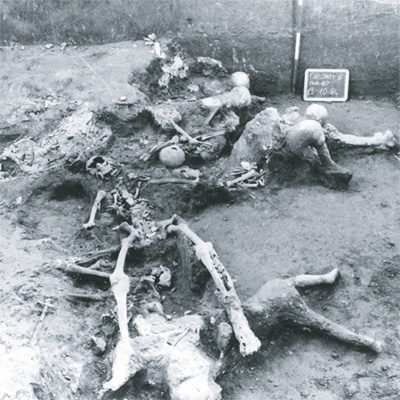
Italy, 79 AD. Vesuvius erupts, throwing up a high-altitude column from which ash began to fall, blanketing Pompeii and surrounding areas, and creating an invaluable archaeological record, preserved for almost 2,000 years.
It is estimated 10% of the city's population did not manage to escape in time, and from the city's well-preserved remains, there is evidence of more than 1,000 casualties recovered so far, many in the form of plaster casts from the impressions the victims' bodies left in the ashes. Some show people lying on their backs or sides in an – apparently – relaxed posture, but most look as if, for one horrible instant, time stood still.
The eerie, life-like poses of the unfortunate who fell to the volcano's temper, are a striking reminder of the victims' individuality, and make it impossible not to wonder how exactly they've died.
How did the Pompeiians die?
Most of Pompeii's inhabitants who survived the early phase of the eruption, during which buildings collapsed, died by exposure to extreme heat, according to the Italian study. A hot mixture of fine ash and hot gas came flowing down the volcano's slopes, a raging current which caused numerous fatalities at Pompeii, about 10kms from the volcano's vent. The researchers found that even at the flow's termination point, temperatures of over 250°C caused instant death. Until now it was believed that many who survived the early eruptive phase were later suffocated by ash.
The study, authored by Giuseppe Mastrolorenzo, Pierpaolo Petrone, Lucia Pappalardo and Fabio M. Guarino and published in open access journal PloS ONE, used digital models of the pyroclastic surges to compute size, density and velocity, as well as analysing human remains from the Pompeii archaeological site, Herculaneum and Oplontis.
Lava? Try Pyroclastic FlowsThe 79 AD Vesuvius eruption caused six major pyroclastic surges and flows, each increasing in power. The three early surges stopped ahead of Pompeii's north-western walls, while the three later surges passed over the town. Although less powerful than the last two surges (whose reach extended more than 15 km from the vent), and in spite of little material damage and an ash deposit of only 3cm, the fourth pyroclastic surge (S4) caused most of the fatalities at Pompeii.

Heat-shock Forensics
In their search for evidence of S4's lethal effects, the scientists studied the casts and skeletons' body postures of some of the 650 victims preserved in the deposits of the S4 surge, hitherto supposed to have died from asphyxiation. For comparison, they also studied 37 corpses discovered at the seaside site of Oplontis and 78 skeletons unearthed at Herculaneum. Impact-like symptoms such as ruptured body parts, are rare, leading the scientists to conclude the S4 flow's dynamic overpressure was below the human lethal threshold. More surprising was that 73% of the S4 victims examined were found to have a 'life-like stance'. Death was so sudden, that the victims died mid-movement.
The researchers consider the widespread occurrence of this stance to be key evidence that most of the victims were alive at the time of posture arrest, and that they all were exposed to the same lethal conditions.
They say the sheer number of victims 'frozen in action' is indicative of a condition known as 'cadaveric spasm'. Often associated with violent death, it means an instantaneous rigor occurs, crystallizing the last activity prior to death. Cadaveric spasm commonly involves only groups of muscles. Only exceptionally – for example in battle situations, due to exposure to extreme heat – would it affect the entire body.

Getting the Temperature Just Right
In order to verify their theory of instant death caused by the heat-shock, the researchers heated human bones to above 200°C (the human survival threshold) and compared colour and texture modifications to the bones of the S4 victims. The tests suggest that bones from Pompeii were exposed to temperatures between 250° and 300°C. The Herculaneum and Oplontis skeletons were exposed to temperatures up to 500° and 600°C respectively.
According to the authors, such temperatures would also explain the well-preserved body imprints found at Pompeii: “The heat was enough for sudden and complete vaporization of soft tissues of the victims at Herculaneum and Oplontis, where the flesh was suddenly replaced by the ash, but was insufficient at Pompeii. This accounts for the nearly perfect preservation of the entire body imprint (as shown by the plaster casts) in the ash as a consequence of the delayed disappearance of flesh of these bodies.”
The estimated 250° to 300°C temperature is also consistent with the melting of ancient Roman silverware, but not glass, at Pompeii.
Frozen in Action, Cooked Alive. Does that hurt?Can we fully exclude that the hot ash particles caused suffocation? The researchers argue that, although the concentration of inhalable ash particles approached a lethal level, the S4 cloud passed too quickly to cause asphyxia. The time Pompeii's citizens were exposed to the ash cloud was too short, suffocation as cause of death would have required a longer exposure time, resulting in several minutes of sheer agony - and loss of muscle tone, inconsistent with the 'life-like' postures.
What about the suffering involved with being cooked alive? At Pompeii, a rise of temperature to more than 250°C in less than 30 seconds, would have (hopefully) heated the victims brains to a point of unconsciousness within a few seconds, as well as instantly boiled the victims' nerve endings.
Good thermopalia or not, I don't think I'll be moving anywhere near an active volcano anytime soon.

